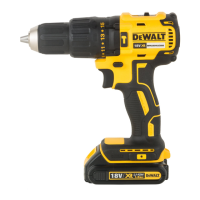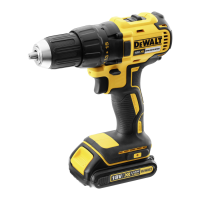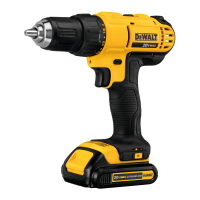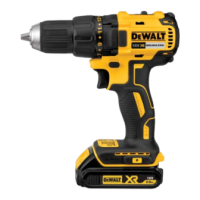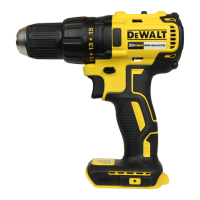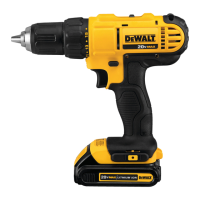9
ENGLISH
These drills/drivers/hammerdrills are professional powertools.
DO NOT let children come into contact with the tool.
Supervision is required when inexperienced operators use
thistool.
• Young children and the infirm. This appliance is not
intended for use by young children or infirm persons
withoutsupervision.
• This product is not intended for use by persons (including
children) suffering from diminished physical, sensory or
mental abilities; lack of experience, knowledge or skills
unless they are supervis`ed by a person responsible for their
safety. Children should never be left alone with thisproduct.
ASSEMBLY AND ADJUSTMENTS
WARNING: To reduce the risk of serious personal
injury, turn tool off and disconnect battery pack
before making any adjustments or removing/
installing attachments/accessories or when making
repairs. An accidental start-up can causeinjury.
WARNING: Use only DeWALT battery packs andchargers.
Inserting and Removing the Battery Pack
from the Tool (Fig. B)
NOTE: Make sure your battery pack
7
is fullycharged.
To Install the Battery Pack into the Tool
Handle
1. Align the battery pack
7
with the rails inside the tool’s
handle (Fig. B).
2. Slide it into the handle until the battery pack is firmly seated
in the tool and ensure that you hear the lock snap intoplace.
To Remove the Battery Pack from the Tool
1. Press the release button
8
and firmly pull the battery pack
out of the toolhandle.
2. Insert battery pack into the charger as described in the
charger section of thismanual.
Fuel Gauge Battery Packs (Fig. B)
Some DeWALT battery packs include a fuel gauge which
consists of three green LED lights that indicate the level of
charge remaining in the batterypack.
To actuate the fuel gauge, press and hold the fuel gauge button.
A combination of the three green LED lights will illuminate
designating the level of charge left. When the level of charge
in the battery is below the usable limit, the fuel gauge will not
illuminate and the battery will need to berecharged.
NOTE: The fuel gauge is only an indication of the charge left on
the battery pack. It does not indicate tool functionality and is
subject to variation based on product components, temperature
and end-userapplication.
Belt Hook and Magnetic Bit Holder (Fig.A)
(Optional Accessories)
WARNING: To reduce the risk of serious personal
injury, DO NOT suspend tool overhead or suspend
objects from the belt hook. ONLY hang tool’s belt hook
from a workbelt.
WARNING: To reduce the risk of serious personal
injury, ensure the screw holding the belt hook issecure.
IMPORTANT: When attaching or replacing a belt hook or
magnetic bit holder, use only the screw that is provided. Be sure
to securely tighten thescrew.
A belt hook
10
and magnetic bit holder
12
can be be attached
to either side of the tool using only the screw
11
provided,
to accommodate left- or right-handed users. If the hook or
magnetic bit holder is not desired at all, it can be removed from
thetool.
To move belt hook or magnetic bit holder, remove the screw
11
that holds it in place then reassemble on the opposite side.
Be sure to securely tighten thescrew.
Variable Speed Trigger Switch (Fig.A)
To turn the tool on, squeeze the trigger switch
1
. To turn the
tool off, release the trigger switch. Your tool is equipped with
a brake. The chuck will stop as soon as the trigger switch is
fullyreleased.
NOTE: Continuous use in variable speed range is not
recommended. It may damage the switch and should
beavoided.
Forward/Reverse Control Button (Fig.A)
A forward/reverse control button
2
determines the direction of
the tool and also serves as a lock-offbutton.
To select forward rotation, release the trigger switch and
depress the forward/reverse control button on the right side of
thetool.
To select reverse, depress the forward/reverse control button on
the left side of thetool.
The center position of the control button locks the tool in the off
position. When changing the position of the control button, be
sure the trigger isreleased.
NOTE: The first time the tool is run after changing the direction
of rotation, you may hear a click on start up. This is normal and
does not indicate aproblem.
Torque Adjustment Collar (Fig.A)
Your tool has an adjustable torque screwdriver mechanism for
driving and removing a wide array of fastener shapes and sizes
and in some models, a hammer mechanism for drilling into
masonry. Circling the collar
3
are numbers, a drill bit symbol,
and on some models, a hammer symbol. These numbers are
used to set the clutch to deliver a torque range. The higher the
number on the collar, the higher the torque and the larger the
fastener which can be driven. To select any of the numbers,
rotate until the desired number aligns with thearrow.
Dual Range Gearing (Fig.A)
The dual range feature of your drill/driver/hammerdrill allows
you to shift gears for greaterversatility.
